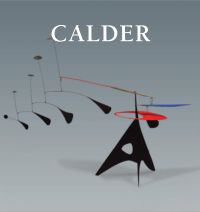Calder
Éditeur : Parkstone International
ISBN numérique PDF: 9781780424651
Catégorisation :
Livres numériques /
Autre /
Autre /
Autre
Formats disponibles
| Format | Qté. disp. | Prix* | Commander |
|---|---|---|---|
| Numérique PDF Protection acs4*** |
Illimité | Prix : 4,00 $ |
*Les prix sont en dollars canadien. Taxes et frais de livraison en sus.
***Ce produit est protégé en vertu des droits d'auteurs.
Description
Alexander Calder was an American sculptor, born in Philadelphia in 1898 and died in 1976 of a heart attack in New York, where he had gone to open a retrospective of his work. Son of two artists, and himself a trained enineer, Calder mostly created mobiles, assembled from pieces that would move with the currents of the air, stabiles or stationary statues made from cut sheet metal, and paintings. His art is poetic, merry and popular, the sublimation of a tree in the wind according to Marcel Duchamp. He went on to develop a fascination with the theme of the circus, which reached its zenith with his Calder Circus, created in Paris in 1926. He moved to France in 1927, where he met artists of the Parisian avant-garde movement, such as Joan Miró, Jean Cocteau, Fernand Léde, and Piet Mondrian in 1930, who would influence his art profoundly. Calder henceforth abandoned figurative wire-sculptures, on which he had concentrated since 1926, to adopt an entirely abstract sculptural language. In 1931, he joins the group Abstraction-Creation, which devoted itself to non-figuration. He also starts to create sculptures made with independent mobile elements, turned by an electric motor or cranked by hand. In 1932, he exhibits 30 sculptures, classed as mobiles by Marcel Duchamp, marking the beginning of his career. In 1958, he creates a mobile for the Parisian seat of UNESCO. Alexander Calder was the most frnch of American sculptors, and his genius is shown by the way he could transform sheet metal into a work of art, and a tin can into a bird. He was the link between surrealism and abstract art.
Du même auteur...
| Livre papier | 0 |
Prix membre : 37,76 $ Prix non-membre : 41,95 $ |

Auguste Rodin : la sculpture nue
Éditeur : EYROLLES
ISBN : 9782212566703
Parution : 2017























